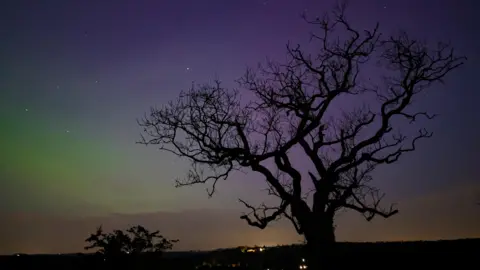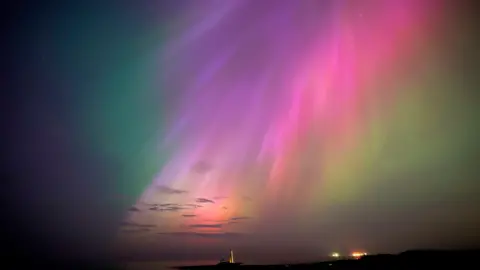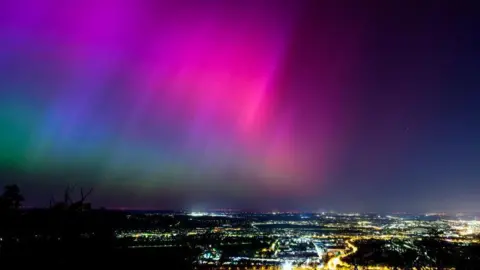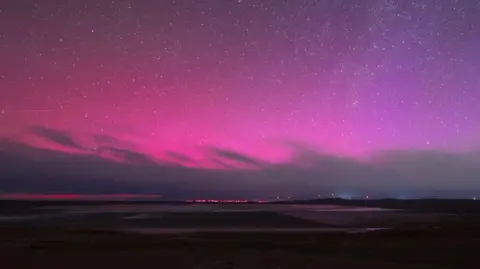Simon King,Jacqueline Howard
 David Severn
David Severn BBC Weather Watchers/Shamrock_Sean
BBC Weather Watchers/Shamrock_SeanThe Northern Lights have made a rare appearance across the UK, delighting sky watchers up and down the country.
Excited onlookers shared pictures of the lights, also known as aurora borealis, visible right across the country, including the south coast of England – and if you missed it you are likely to have a chance to see it again on Saturday night.
They could be seen after one of the strongest geomagnetic storms for years hit Earth, with the US National Oceanic and Atmospheric Administration (NOAA) issuing a rare solar storm warning.
Such storms increase people’s chances of seeing the lights.
The extreme geomagnetic storm that happened on Friday was classed as the highest G5.
Storms of this scale could potentially impact infrastructure, including satellites and the power grid, the NOAA warned.
The last big G5 storm caused a power outage in Sweden, but there have been no reports of disruption so far.
“The energy industry plans for a range of events far and wide – including into space,” Ross Easton, a spokesperson for Energy Networks Association said, adding that space forecasts were being monitored carefully over the weekend.
Prof Carole Haswell, head of astronomy at the Open University, told BBC Radio 4’s Today programme that a lot of satellites communicate using radio signals.
“All of these charged particles speeding around disrupt radio signals, particularly GPS which is used by planes.”
Clear skies – like those on Friday evening – made sightings possible from almost everywhere in the UK.
In Thorngumbald, east Yorkshire, Sarah Sharp said seeing the lights was a “dream come true”.
“It was truly spectacular, probably a once in a lifetime experience, it’s certainly the first time I’ve seen them. We spent about an hour watching them move across the sky.”
Aurora activity is expected again on Saturday and while the geomagnetic storm is still expected to be in the “strong” category, early indications are that it may not reach the extreme of Friday.
Weather conditions are again expected to be ideal but it needs to be dark so you will need to wait until at least 22:30 BST.
 PA Media
PA MediaHow rare is it to see the Northern Lights?
The last time an extreme geomagnetic storm hit Earth was in 2003, so Friday’s event was rare. We are much more used to seeing the Northern Lights limited to northern parts of the UK.
There have been more occasions in the last year or so where we’ve had a weak showing of the aurora in southern parts of the UK.
This is because in its 11 year solar cycle, we are approaching the ‘solar maximum’ where there are naturally more sunspots on the Sun’s surface.
Sunspots are like huge volcanos erupting charged particles in Coronal Mass Ejections (CME’s). With more of them at the moment, there’s a greater chance of more frequent and strong auroral activity.
It is also worth pointing out that because we can forecast these events better and with most of us having a smart phone able to capture the bright lights of the aurora, there has been an increase in sightings over the last decade or two.
However, as always, anywhere away from light pollution with a clear view of the night sky will give you the best chance of seeing them.
 BBC Weather Watchers/Mbphoto999
BBC Weather Watchers/Mbphoto999Lights dazzled sky-watchers all over the world
In the US, the NOAA said the lights could be seen as far south as Alabama and northern California.
Many of Europe’s northern countries were treated to the spectacle as well.
Cameras captured bright pink skies over Austria, and a purple wash over Germany, with watchers in Slovakia, Switzerland, Denmark and Poland among others who enjoyed the light show.
The lights were captured in China, too, with fuchsia skies photographed over the country’s north.
 Getty Images
Getty Images Getty Images
Getty ImagesWhat makes the sky pink?
The Northern Lights – or aurora borealis – appear as bright, swirling curtains of lights in the night sky and range in colour from green to pink and scarlet.
It is caused by charged particles from the sun hitting gases in the Earth’s atmosphere.
The colours occur due to different gases in the Earth’s atmosphere being energised by the charged particles.
The two most common gases in the Earth’s atmosphere are nitrogen and oxygen. Oxygen atoms glow green – the colour most often seen in the Northern Lights, while nitrogen atoms emit purple, blue and pink.
The most impressive auroras occur when the Sun emits really large clouds of particles called “coronal mass ejections”.

